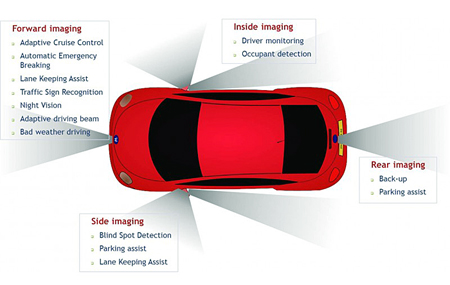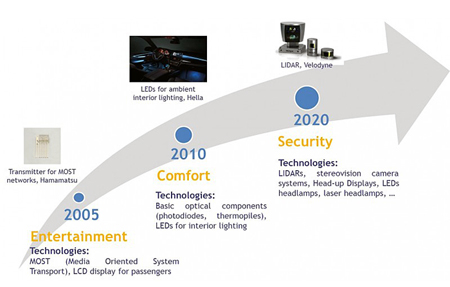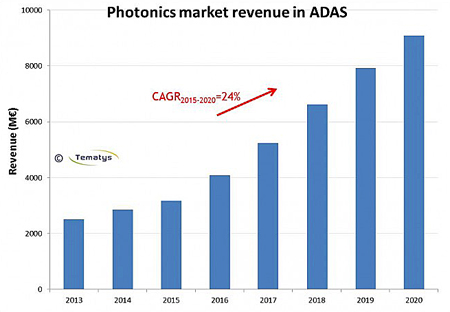Over the past 15 years or so, car manufacturers have been showing increasing interest in new technologies – especially photonics-based developments – in all areas: from powertrain, through lighting to driver assistance and vision systems.

Market analyst Tematys, which has just released a new report into this sector, says photonic technologies have significantly enabled developments such as high-performance electric vehicles, laser-based headlamps and optically-assisted parking systems.
Tematys comments, “The trend toward innovation is a huge opportunity for the photonics industry. Until relatively recently, photonics was integrated into car only through lighting functions. However, photonic technology provide critical functions for imaging, sensing, smart displaying or for media communication networks. As a consequence, photonics is expected to be widely adopted beyond lighting."
The €4990.00 report presents the market segmentation of existing and likely future photonics technologies to be embedded into cars as well as market forecasts for photonics integration into market segments such as: Advanced Driver Assistance System (ADAS), interior of the cabin, exterior of the car, and powertrain (delivery of power from engine through to the road).
Explaining how the company defines photonics technologies, Benoît d'Humières, partner at Tematys, told optics.org, "We employ a broad definition including the science and all technologies and systems that generate, transmit, detect, collect, modulate, amplify flux, from the terahertz band at around 300GHz through to X-rays."

ADAS ‘most promising’
Demand for considerably fewer accidents has been expressed by a number of stakeholders worldwide. According to the U.S. Department of Transportation’s National Highway Traffic Safety Administration (NHTSA), human error is the critical reason in around 90% of all car accidents.
Tematys says that the automation of certain driving tasks could help reduce the human error factor and so the number of car crashes. It is the reason why Advanced Driver Assistance Systems (ADAS) are now being developed and implemented in new cars.
“Photonics is a key enabler of ADAS. Indeed, cameras, combined with non photonic technologies already allow reliable parking assistance. LIDAR systems and new types of cameras will enable new functions such as automatic emergency braking. Infrared camera systems or adaptive frontlighting will allow safer driving at night,” says the introduction to the report.
ADAS to grow at 22% CAGR
ADAS is one of the most promising segments in terms of economic perspective for photonic technologies manufacturers. Indeed, the market of Photonics in ADAS will grow from around € 2.8b in 2014 to around € 9b in 2020 with a CAGR2015-2020 of around 22%.

Currently restricted to few thousands of units per year in the luxury car segment, high-end photonic systems have the potential to reach tens or hundreds of millions units/year, says the report.
“This is thanks to strong cost decreases while maintaining ADAS technologies’ high performance abilities.” The report also presents detailed market forecast by photonics technologies in ADAS from 2013 to 2020, as well as likely adoption rates over this period.
The report also mentions the contributions made by a number of key suppliers of components and sub-systems, including: Advanced Scientific Concepts, CMOSIS, Cognivue, CSEM, Efkon, Excelitas, FLIR, Fraunhofer IZM, Hamamatsu, Ibeo, Innov+, LeddarTech, Lemoptix, Mesa Imaging, Mobileye, Navdy, OledComm, Omnivision, ON Semiconductor, Osram, Philips, PMD Technologies, PureLiFi, Samsung, Sensata, Seoul Semiconductor, Sony, ST Microelectronics, Stereolabs, Texas Instruments, Two Trees Photonics, Ulis, Velodyne, and Vislab.





